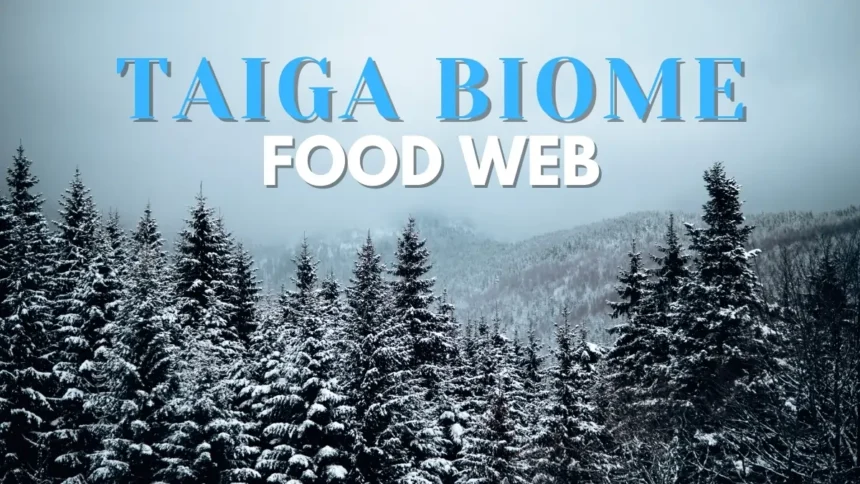Introduction
Welcome to the taiga biome food web, a fascinating world of towering conifers, a harsh environment where life clings to survival through predator and prey relationships. It is Earth’s largest terrestrial biome.
The taiga biome food web is a complex network of interactions between various organisms, from the smallest microorganisms to the largest apex predators. Every living being plays a crucial role in maintaining the ecosystem’s delicate balance in this frozen wilderness. For instance, coniferous trees provide food for insects, which birds eat. These birds may, in turn, be prayed upon by larger predators, such as owls or wolves.
This article will explore the taiga biome food web, its unique characteristics, the diverse organisms that call it home, and the intricate relationships that bind them. We will journey through the various trophic levels, starting with the producers that form the foundation of the food web, moving on to the herbivores and carnivores that rely on them for sustenance, and finally, the decomposers that recycle nutrients back into the ecosystem.
It will also shed light on the threats facing this fragile ecosystem and discuss the importance of conservation efforts to protect the taiga biome food web for future generations.
Geographical Distribution of the Taiga Biome
The taiga regions of North America and Eurasia form broad belts of vegetation stretching from the Atlantic to the Pacific coasts of their respective continents.
In North America, the taiga covers much of Canada and Alaska, with transitional forest types present in the northern tier of the lower United States. However, true taiga stops just north of the southern Canadian border.
In Asia, the vast taiga extends across Russia and southward into northeastern China and Mongolia, creating extensive ecosystems rich in biodiversity and essential for complex food chains and webs.
Characteristics of Taiga Biome
Climate
- The climate of taiga ecosystems is mainly cold, although this biome has a surprising diversity of climates. Several factors contribute to this cold climate, including the solar elevation angle, length of the day, and snow cover. In contrast to tropical rainforests, the Sun is never overhead in the taiga biome.
- The maximum solar angle decreases with increasing latitude. At latitude 50° N in the southern part of the taiga, it is 63.5°, while at the Arctic Circle, it is only 47°.
- Consequently, solar energy is less intense in the taiga because it is spread over a greater area of Earth’s surface than in equatorial regions. This impacts the food web and biodiversity within the ecosystem.
- Factors like climate change, global warming, and pollution further influence these. Understanding these dynamics is crucial for preserving the taiga biome’s intricate food chains and biodiversity.
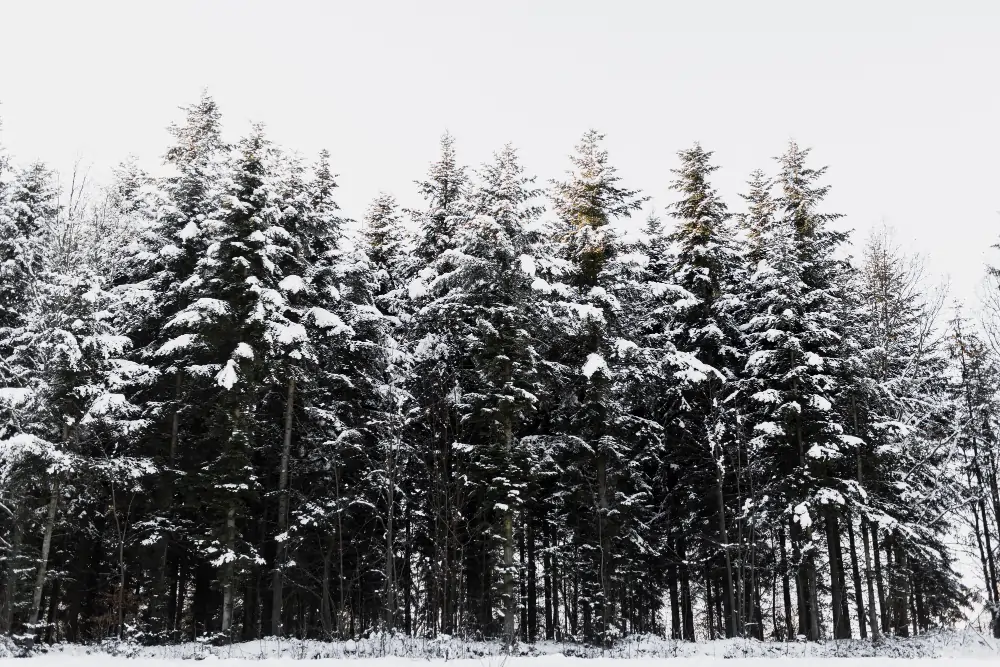
Vegetation
- The species composition of the Eurasian taiga biome varies significantly, with different species dominating east of central Siberia compared to those westward into Europe.
- Scotch pine is the world’s most widely distributed pine species, extending from northern Scotland to the Russian Pacific shore.
- In the European taiga ecosystem, distinctive species include the Norway spruce (Picea abies), which dominates the humid, productive parts of the taiga, and the Sukaczev larch (Larix sukaczewii), an early successional species in European Russia.
- In North America, most tree species are found across the continent, except for jack pine (Pinus banksiana), lodgepole pine (Pinus contorta), and balsam fir (Abies balsamea).

The biodiversity within these ecosystems contributes to complex food chains and food webs, which are essential for maintaining ecological balance. However, climate change poses significant threats to these biomes, impacting species distribution and ecosystem stability, much like the challenges rainforests face to global environmental changes.
Components of the Taiga Biome Food Web

▶ Producers
The taiga biome comprises coniferous trees like spruce, fir, and pine. These trees are well adapted to the cold climate of this ecosystem, featuring needle-like leaves that reduce water loss through transpiration. This adaptation supports the biodiversity within the taiga, forming the foundation of its food web and contributing to complex food chains.
● Coniferous trees
Taigas are dense forests primarily composed of coniferous trees like spruce, pine, and fir. These trees have needles instead of broad leaves; their seeds develop inside protective, woody cones. Unlike the deciduous trees of temperate forests, which shed their leaves in winter, conifers retain their needles year-round. This characteristic earns them the name “evergreens.” The resilience and adaptability of these trees play a crucial role in maintaining the food chain, food web, and biodiversity within the taiga biome, contributing to the ecosystem’s overall health.
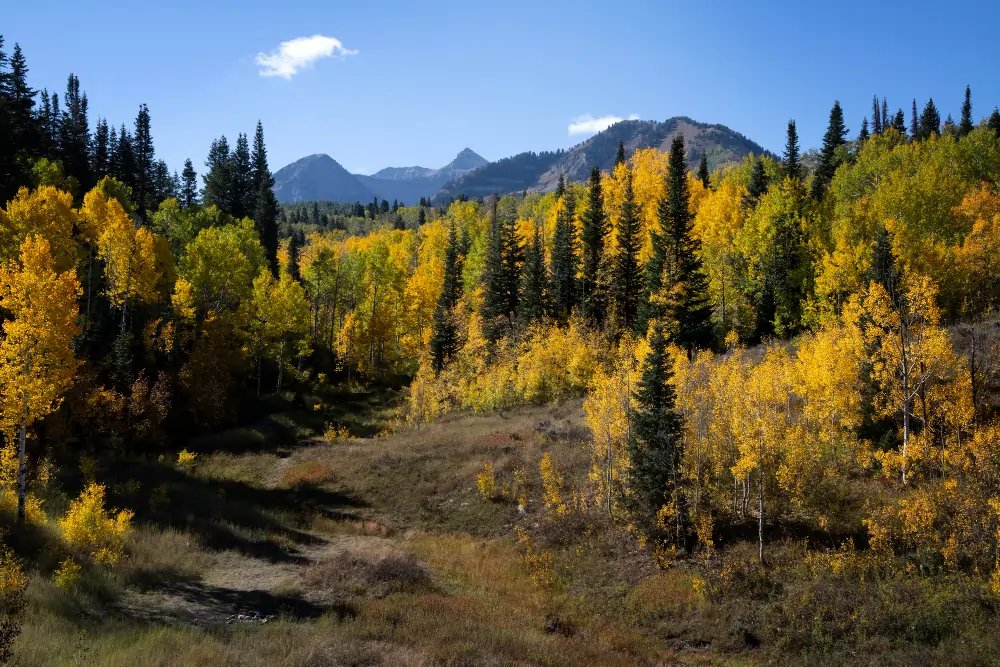
● Other vegetation
Taigas have limited native plants besides conifers. The nutrient-poor soil, which can also freeze, makes it challenging for many plants to establish roots in this biome. The larch is one of the few deciduous trees that can survive the harsh conditions of the northern taiga.
Instead of shrubs and flowers, the forest floor of a taiga is covered with mosses, lichens, and mushrooms. These organisms, which play essential roles in the food web and chain, can grow directly on the ground or have very shallow roots, enabling them to survive in the cold with minimal water or sunlight. This unique vegetation supports the biodiversity of the taiga ecosystem, similar to how diverse plant life supports the complex food webs in rainforests.
▶ Primary Consumers (Herbivores)
In the taiga food chain, herbivores play a very important role in maintaining the balance of the ecosystem. A few of the primary herbivores in the taiga biome include:
Moose: A large mammal that feeds on various vegetation, such as aquatic plants, shrubs, and tree bark.
Snowshoe Hare: Known for their fur changing color in seasons, these hares eat grasses, ferns, and leaves in summer and bark and twigs in winter.
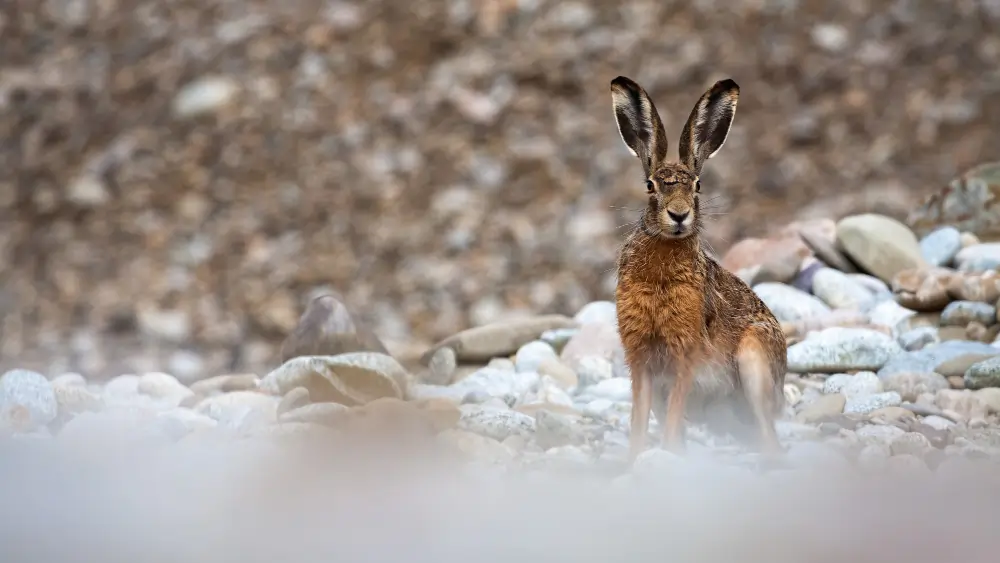
These herbivores, predominantly mammals like moose, snowshoe hares, and rodents, sustain themselves by feeding on the abundant vegetation in this biome, particularly coniferous trees, shrubs, and grasses.
Herbivores are significant in the Taiga biome food web because they convert plant matter into energy, making it accessible to higher trophic levels. By consuming plants, herbivores effectively transfer energy and nutrients, ensuring the survival of carnivores and omnivores that prey upon them.
▶ Secondary Consumers (Carnivores)
One common animal in the taiga biome is the red fox. Characterized by its rusty-red fur, white-tipped bushy tail, black legs, ears, and nose, the red fox is a versatile and intelligent predator. It adapts well to various habitats and specializes in hunting small mammals, such as rabbits and hares, positioning it as an important carnivore in the food chain.
The red fox’s adaptability and predatory behavior contribute to the taiga ecosystem’s biodiversity and complexity, akin to the intricate food webs in rainforests. By preying on small animals, the red fox helps maintain the balance and diversity of the taiga biome.
River otters, another secondary consumer, inhabit the taiga biome, contributing significantly to the food chain and ecosystem diversity. As omnivores, they consume plants and other animals, including fish, shellfish, crustaceans, snails, beetles, amphibians, and small mammals. River otters are vital in maintaining the taiga’s food web, similar to how diverse species interact in a rainforest.
Mid-level predators like lynx and wolverines are uniquely positioned in the Taiga biome food web. Lynx, with their tufted ears and exceptional agility, are specialized hunters of snowshoe hares, relying on stealth and surprise to secure their meals. Wolverines, on the other hand, are opportunistic feeders, scavenging on carrion and taking down smaller prey like rodents and birds. Their adaptability and tenacity allow them to thrive in the challenging taiga environment.
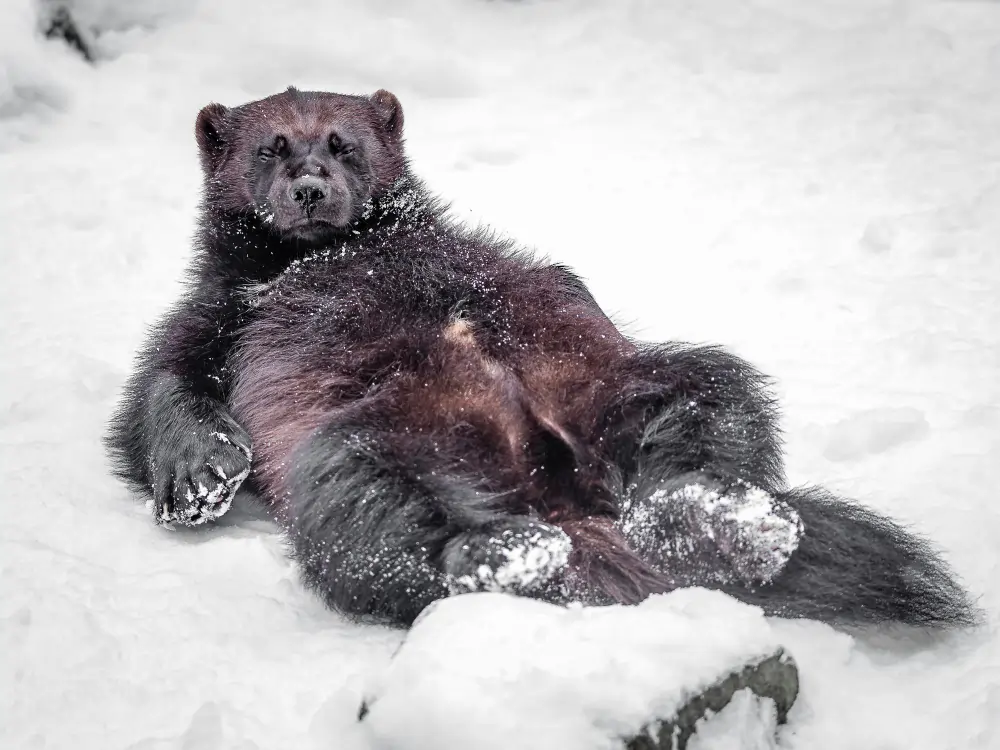
The skies above the taiga are patrolled by avian predators like owls and hawks, which play an essential role in the Taiga biome food web. With their silent flight and keen eyesight, owls are nocturnal hunters of rodents and small mammals. Conversely, Hawks utilize their sharp talons and powerful vision to capture prey from above during daylight hours. These birds of prey adapt to seasonal changes in prey availability, switching their focus to different species as the taiga landscape transforms throughout the year.
▶ Tertiary Consumers
Apex predators like wolves and bears sit at the top of the Taiga biome food web. These formidable hunters play a crucial role in regulating populations of large herbivores, such as moose and caribou. Wolves, renowned for their pack-hunting tactics, take down prey through coordinated attacks, while bears utilize their immense strength and sharp claws to subdue their victims. By keeping herbivore numbers in check, apex predators prevent overgrazing, which could harm the entire Taiga biome food web.
▶ Decomposers in the Taiga
Fungi are the primary decomposers in the taiga biome, breaking down litter and organic matter. However, bursts of bacterial growth can occur in response to specific triggers. Soil animals typically do not directly decompose forest litter; instead, they influence the process by grazing on fungi and bacteria.
In the taiga ecosystem, the decomposition rate does not match the rate of organic matter production, leading to a progressive accumulation of organic material. This dynamic is a crucial part of the taiga food chain and food web, contributing to the overall biodiversity and health of the biome, similar to the decomposition processes in rainforests.
The Taiga Food Web in Action
The Taiga biome food web is a dynamic system where energy flows and nutrients cycle through a complex network of interactions. Sunlight fuels the growth of producers consumed by herbivores, providing sustenance for predators. Decomposers play a crucial role in breaking down organic matter, returning nutrients to the soil, and thus completing the cycle.
Threats to the Taiga Food Web
With its intricate food web, the taiga biome is increasingly vulnerable to a range of natural and anthropogenic threats. These disturbances can disrupt the ecosystem’s delicate balance, leading to cascading effects throughout the food chain.
Fluctuations in temperature, precipitation, or the introduction of invasive species can trigger cascading effects throughout the web. For example, a decrease in snowshoe hare populations due to disease can impact their predators (lynx) and food sources (plants). Understanding these intricate connections is crucial for conserving the Taiga biome food web and ensuring its long-term resilience.
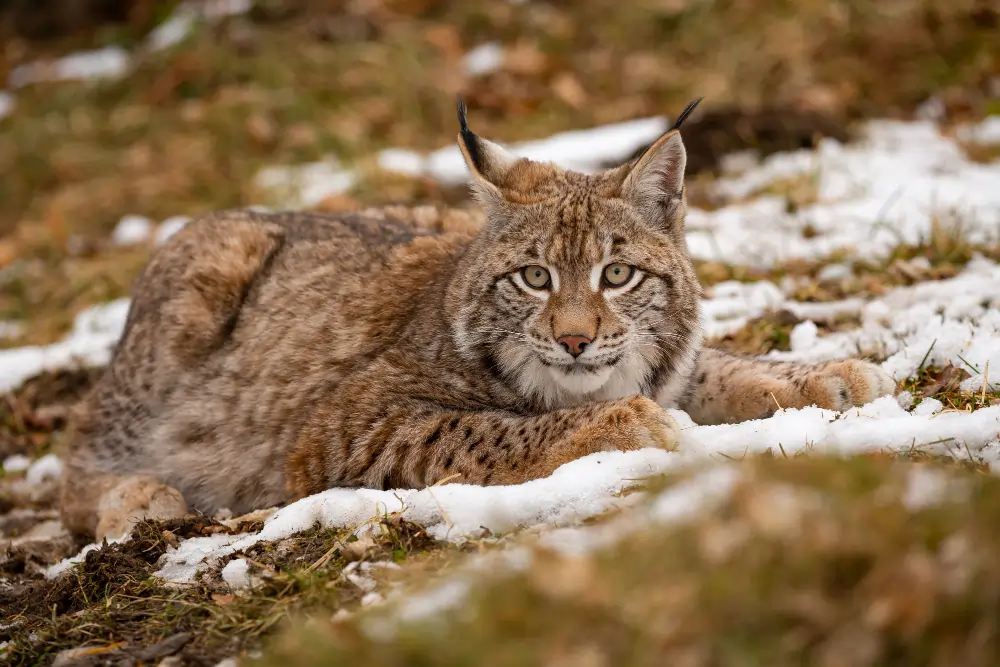
Climate Change and the Taiga
Climate change poses a significant threat to the taiga biome. Rising temperatures are changing precipitation patterns, leading to droughts in some areas and flooding in others. This disrupts the fragile balance of the ecosystem, affecting plant growth and animal behavior.
Furthermore, warmer temperatures are causing the permafrost to thaw, releasing greenhouse gases and further exacerbating climate change. These changes threaten the biodiversity of the taiga, as many species are adapted to specific conditions and may not be able to survive in a rapidly changing environment.
Human Activities
Human activities, such as logging and deforestation, are major contributors to the degradation of the taiga biome. These practices destroy habitats and fragment the landscape, making it difficult for animals to move and find food. Mining and resource extraction further disrupt the ecosystem, polluting waterways and displacing wildlife.
Industrial pollution and the burning of fossil fuels also have detrimental effects on the taiga. Acid rain damages plants and soils, while air pollution can harm animals and disrupt their respiratory systems. These human-induced threats, combined with the effects of climate change, pose a serious risk to the future of the taiga biome food web.
Conservation Efforts
- Protected Areas and Conservation Reserves: Establishing and expanding protected areas like national parks and wildlife reserves safeguards critical habitats and allows natural ecological processes to continue undisturbed.
- Sustainable Forestry Practices: Implementing sustainable logging methods that prioritize selective harvesting, reforestation, and minimizing habitat fragmentation can reduce the forestry industry’s negative impact on the taiga ecosystem.
- Climate Change Mitigation: Global efforts to reduce greenhouse gas emissions and transition towards renewable energy sources are crucial to mitigate the effects of climate change on the taiga biome.
- Responsible Resource Extraction: Regulating and monitoring activities such as mining and oil and gas exploration to minimize habitat destruction and pollution. Encouraging the use of best practices to reduce environmental impact is key.
- Community Engagement and Education: Involving local communities in conservation efforts, providing education about the importance of the taiga biome, and promoting sustainable livelihoods can create a sense of ownership and encourage long-term stewardship.
- Scientific Research and Monitoring: Continued research on the taiga biome food web can help identify key threats, assess the effectiveness of conservation measures, and inform adaptive management strategies.
- International Cooperation: Collaborating across borders to address transboundary issues such as wildlife migration, pollution, and climate change is essential for the long-term conservation of the taiga biome.
- Individual Approach: An individual can achieve this, for instance, by recycling paper to decrease tree cutting, which will increase carbon dioxide absorption and reduce carbon dioxide. Another way is by using lower-timber forest items. Another initiative the government needs to take is planting trees to eliminate carbon dioxide in the air.
Conclusion
In conclusion, the taiga food web exemplifies this unique biome’s complex interactions and biodiversity. From primary producers like coniferous trees and decomposers like fungi to herbivores such as moose and secondary consumers like the red fox and wolverine, each organism plays a vital role in maintaining the ecosystem’s balance.
However, it faces significant challenges due to human activities and climate change. Understanding the importance of this unique ecosystem and its threats is the first step toward protecting it. We must act now to safeguard the Taiga biome food web. By supporting sustainable practices, advocating for responsible resource management, and raising awareness about the value of this biome, we can contribute to its preservation for future generations.
Let us join hands to protect the intricate Taiga biome food web and ensure the survival of its diverse species. No matter how small, every action can make a difference in preserving this vital ecosystem.
References
- Importance of the Taiga and how to conserve it. (n.d.). Taiga Forest Bakies. Retrieved May 23, 2024, from http://stevagon-osu.weebly.com/importance-of-the-taiga-and-how-to-conserve-it.html
- Flexi answers – What is a taiga food web? (2023, July 25). Ck12.org. https://www.ck12.org/flexi/earth-science/flow-of-energy-in-ecosystems/what-is-a-taiga-food-web/
- Juday, G. P. (2024). taiga. In Encyclopedia Britannica.
- Taiga. (n.d.). Nationalgeographic.org. Retrieved May 23, 2024, from https://education.nationalgeographic.org/resource/taiga/
- Secondary Consumers. (n.d.). Taiga. Retrieved May 23, 2024, from https://allabouttaigas2013.weebly.com/secondary-consumers.html
- Tertiary Consumers. (n.d.). Taiga. Retrieved May 23, 2024, from https://allabouttaigas2013.weebly.com/tertiary-consumers.html
- Taiga – insects, Biodiversity, Ecosystems. (n.d.). In Encyclopedia Britannica.
FAQs
1. What is the taiga biome food web?
The taiga biome food web is a complex network of interconnected relationships between organisms living in the taiga. It illustrates how energy flows through the ecosystem, from producers (plants) to consumers (animals) and decomposers (fungi and bacteria). Each organism plays a specific role in maintaining the balance of this unique ecosystem.
2. What are the key producers in the taiga biome food web?
Coniferous trees like spruce, fir, and pine are the primary producers of the taiga. They form the foundation of the food web by converting sunlight into energy through photosynthesis. Other producers include shrubs, mosses, lichens, and seasonal berries, all of which contribute to the sustenance of various herbivores.
3. Which animals are at the top of the taiga food web?
Apex predators like wolves, lynx, and bears sit at the top of the taiga food web. These carnivores play a crucial role in maintaining the balance of the ecosystem by regulating populations of herbivores like moose, deer, and snowshoe hares.
4. How do plants survive the harsh winters in the taiga?
Evergreen coniferous trees have adapted to survive the harsh taiga climate. Their needle-like leaves reduce water loss, and their conical shape easily sheds snow. They provide food and shelter for a variety of animals and form the base of the food web.
5. How do animals survive the harsh winters in the taiga?
Animals in the taiga have developed various adaptations to survive the harsh winters. Some, like bears, hibernate to conserve energy during the lean months. Others, like squirrels, cache food during the warmer seasons to ensure sustenance during winter. Many birds migrate south to warmer climates, while some mammals, like snowshoe hares, change their fur color to camouflage with the snow. These adaptations enable animals to endure the extreme cold and limited food availability.
6. How does Climate Change Affect the Taiga Biome Food Web?
Climate change poses a significant threat to the taiga biome food web. Rising temperatures change precipitation patterns, affecting plant growth and animal behavior. Thawing permafrost releases greenhouse gases, further exacerbating climate change. These changes can disrupt the delicate balance of the food web, leading to potential shifts in species distribution and abundance.
7. Why is the taiga biome food web important?
The taiga food web is vital in maintaining the planet’s health. As the largest terrestrial biome, the taiga is a significant carbon sink, absorbing carbon dioxide from the atmosphere and helping to mitigate climate change. The relationships within the food web ensure the balance of populations and the healthy functioning of the ecosystem. This, in turn, supports biodiversity, provides resources for human communities, and contributes to the overall well-being of the planet.

